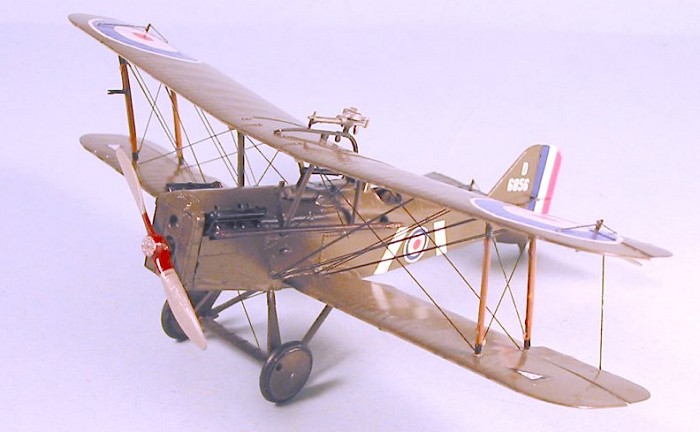
| KIT: | Roden 1/48 SE.5A |
| KIT #: | 416 |
| PRICE: | $19.96 MSRP ($17.96 at Squadron) |
| DECALS: | Three options |
| REVIEWER: | Tom Cleaver |
| NOTES: |

| HISTORY |
The S.E.5a (for Scout-Experimental) was built at the Royal Aircraft Factory and was the first successful design by W.E.W. “Tony” Petter, who would later design the Gloster Gladiator, the Meteor, the English-Electric Canberra and the Folland Gnat.
Appearing in 1917, right after “Bloody April,” as the S.E.5 with an unreliable 150 h.p. Hispano engine, the airplane was seriously underpowered. Modified with the 200 h.p. Hispano in May 1917 as the S.E.5a, the airplane was built by the Royal Aircraft Factory, Austin, Vickers, and Martinsyde. The Hispano was still unreliable, and only 800 S.E.5as were delivered during the rest of 1917. Wolseley modified the Hispano-Suiza 8A into an engine known as the Viper. Speed was increased by 7 mph and climb was increased. This became the 1918 production standard, and by that summer the RAF had 25 squadrons equipped with the S.E.5a.
Where the Camel was tricky and dangerous with its rotary engine, the S.E.5a
was rock-solid with its V-8. If a comparison can be made, the Camel was
the “Spitfire” to the S.E.5a’s “Hurricane.” The S.E.5a bore the brunt of
air combat during the last six months of the war, and was the mount of aces
such as Anthony Beauchamp-Proctor, a South African flying with 54 Squadron
who scored many of his 54 victories with an S.E.5a and Edward “Mick”
Mannock, the Commonwealth Ace of Aces with 73 victories, the majority of
them scored in the S.E.5a. Billy Bishop al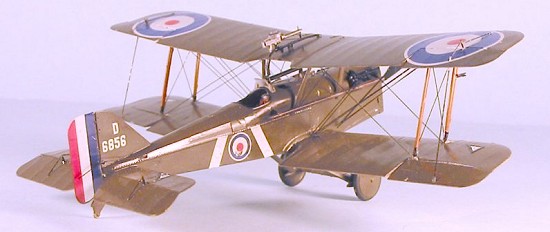 so flew it as C.O. of 85
squadron as did James McCudden of 56 Squadron. Famed aviation writer Cecil
Lewis, author of “Sagittarius Rising” - one of the best books on World War
I combat - flew the S.E.5a at night with 54 Squadron on Home Defense.
so flew it as C.O. of 85
squadron as did James McCudden of 56 Squadron. Famed aviation writer Cecil
Lewis, author of “Sagittarius Rising” - one of the best books on World War
I combat - flew the S.E.5a at night with 54 Squadron on Home Defense.
While the S.E.5a rapidly left RAF service after the war, a version with the 180 h.p. Hispano was the main equipment of the U.S. Army Air Service until the mid-1920s.
Andrew Beauchamp-Proctor - the South African Ace of Aces:
The son of a school teacher, Andrew Beauchamp-Proctor was South Africa's highest scoring ace during World War I and the 5th-ranking Allied ace of the war. He is the South African Ace of Aces with 54 victories including 16 balloons shot down - a remarkable feat since these were among the most heavily-defended targets on the Western Front, making him the and the RAF’s top “balloon buster.”
At the outbreak of the First World War, Beauchamp-Proctor was studying engineering at the University of Cape Town. He abandoned his studies and joined the army, where he served as a signaler in the Duke of Edinburgh's Own Rifles and saw action in German South-West Africa. With the successful campaign finished in the summer of 1915, he left the army that August and returned to his studies. After completing his education, Beauchamp-Proctor joined the Royal Flying Corps in March 1917 and was one of “The Thousand” - the first South Africans to go to England for combat service on the Western Front.
Beauchamp-Proctor was commissioned upon his arrival in England and underwent pilot training. Despite being only 5' 2" tall, so short that he had to use two leather cushions in order to see out of a standard cockpit, he proved an excellent pilot and on completion of training was posted to 84 Squadron in late July 1917. The squadron, commanded by Major William Sholto Douglas - who would later become OC Fighter Command during the Second World War - was equipping with the then-new S.E.5a.
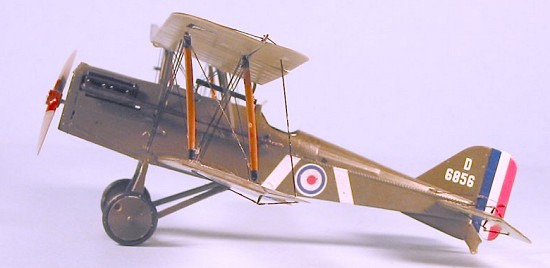 84 Squadron flew to France that September. The war was at its height, and
not going well. The French army had mutinied, and half a million soldiers
of the British Empire were fighting and dying in a bitter struggle for a
place called Passchendaele.
84 Squadron flew to France that September. The war was at its height, and
not going well. The French army had mutinied, and half a million soldiers
of the British Empire were fighting and dying in a bitter struggle for a
place called Passchendaele.
Beauchamp-Proctor scored his first victory in November, 1917, and in the course of the next 5 months proved himself a reliable pilot and became a flight leader in the squadron, scoring steadily. He was wounded in combat on March 11, 1918, at the outset of the final German offensive of the war. Returning on March 21, in his first combat after returning, he saw three German scouts attacking a British 2-seater. He dove to the rescue, shooting down one, then attacked another formation, shooting down two of these.
Beauchamp-Proctor scored steadily during the desperate fighting to stop the German offensive that Spring, and had 28 victories by June when the Allies defeated the Germans and went over to the offensive that would end the war.
In July, leading a flight of five, Beauchamp-Proctor spotted a formation of 30 Fokker D.VIIs and immediately attacked them, shooting down two. That evening, he found another formation and shot down one while forcing two others to collide trying to get away from his ferocious attack. He was awarded the Distinguished Flying Cross for this fight.
Beauchamp-Proctor made his reputation as a balloon buster when he was assigned a mission on August 22 to attack observation balloons on the Ypres front. He blew up the first, then flew on to explode five more, returning to the attack to force down a seventh that exploded on hitting the ground. At this point his score was 33 enemy aircraft, on which he now added seven balloons on one mission, resulting in award of the Distinguished Service Order.
The war was reaching its height with a general offensive all along the
Western Front by British and Commonwealth forces, the French and the
American armies by late August. Beauchamp-Proctor was wounded a second
time in early September, p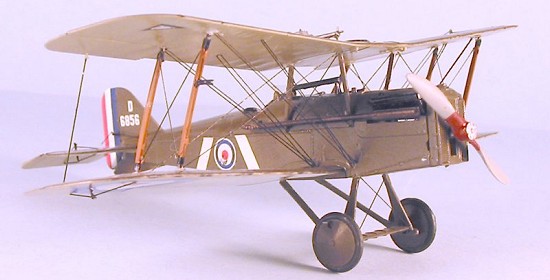 utting him out of action for three weeks before
returning late in the month. On October 1st, he was involved in a dogfight
with 28 Fokkers of the Richtofen Geschwader, during which he shot down two
D.VIIs. The next day he exploded a balloon. Again the next day, he got
another balloon and shot down one of the D.VIIs defending the location.
Two days later on October 5, he shot down a third balloon.
utting him out of action for three weeks before
returning late in the month. On October 1st, he was involved in a dogfight
with 28 Fokkers of the Richtofen Geschwader, during which he shot down two
D.VIIs. The next day he exploded a balloon. Again the next day, he got
another balloon and shot down one of the D.VIIs defending the location.
Two days later on October 5, he shot down a third balloon.
Beauchamp-Proctor’s war ended two days later. On October 8th, while flying home at a low altitude after destroying a 2-seater near Maretz, he was painfully wounded in the arm by machine-gun fire from the ground. He landed safely and after making his report was admitted to hospital.
For his record of 12 balloons and 14 aircraft shot down between August 8th and October 8th, 1918, in addition to leading numerous ground-strafing missions, Andrew Beauchamp Proctor was awarded the Victoria Cross. Additionally, he had been awarded the Military Cross and bar, the Distinguished Flying Cross and the Distinguished Service Order, making him the most-decorated South African soldier of the First World War.
Beauchamp-Proctor returned to South Africa after the war, then returned to England in 1922 and rejoined the Royal Air Force. Because of his special flying skills, he was appointed to the RAF aerobatic squadron, then based at Upavon, Wiltshire. Shortly after, while practicing for an air display, he lost control of his S.E.5a and was killed in the resultant crash.
On hearing of his death, Jan Smuts, then Prime Minister of South Africa, cabled Winston Churchill and asked that the remains be shipped to South Africa for a state funeral. Beauchamp-Proctor was buried in his hometown of Mafeking, South Africa six weeks later. His grave is a National Memorial.
| THE KIT |
There have been four S.E.5a’s (ostensibly) released in 1/48, the first being a kit by Aurora in the 1950s that was later redone and released by Monogram in 1970s, one by Lindberg that was actually an S.E.5 from the 1960s, and one by Blue Max in 1999. Of these, the only one that was really an accurate model of the S.E.5a was the Blue Max limited run kit, which suffered from the “dread wing ripple”.
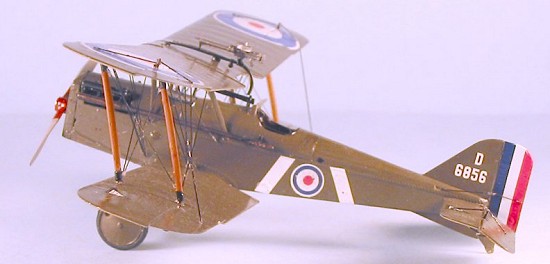 This new kit from Roden effectively makes all of the above kits obsolete.
At under $20 retail, it is well-designed, with superb surface detail, and
looks to be dead-on accurate in shape. From what is on the sprues, this
looks like it will make up as nicely as the Eduard Camel.
This new kit from Roden effectively makes all of the above kits obsolete.
At under $20 retail, it is well-designed, with superb surface detail, and
looks to be dead-on accurate in shape. From what is on the sprues, this
looks like it will make up as nicely as the Eduard Camel.
Those Who Know These Things say that the kit represents a late-1918 production version, due to the extra rib in each wing at the aileron. Since the three aircraft for which markings are provided were all late-production aircraft by service, this is most likely correct for these aircraft. A modeler who wants to be a stickler would have to remove this rib for other aircraft; however, I can also attest to the fact that - once built and painted - the existence of this extra rib is not noticeable at a distance further than 10 inches away unless the light is just right.
Decals are provided for the S.E.5as flown by Andrew Beauchamp-Proctor, Mick Mannock and Billy Bishop.
You can see and read more about it in the preview.
| CONSTRUCTION |
The S.E.5a has a simple design and is very easy to assemble following the kit instructions.
I separated the control surfaces and posed them dynamically. I considered
using some putty to make the “wrinkled” fabric seen on the fuselage of
nearly every S.E.5a, but 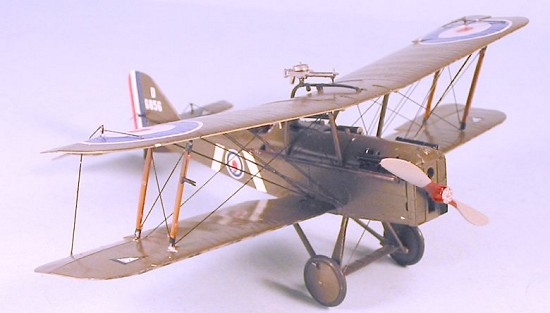 decided
to do that on a future project - and with this kit being as nice as it is
there will be future projects. I painted the interior with Sail Color
to simulate fabric, and my own mixture of “Yew” - a combination of Gloss
Red-Brown and Gloss Cream Yellow - to paint the wooden airframe structure.
decided
to do that on a future project - and with this kit being as nice as it is
there will be future projects. I painted the interior with Sail Color
to simulate fabric, and my own mixture of “Yew” - a combination of Gloss
Red-Brown and Gloss Cream Yellow - to paint the wooden airframe structure.
| COLORS & MARKINGS |
Painting:
Once the model was pre-shaded, the lower surfaces were painted Gunze-Sangyo “Sail Color,” and the upper surfaces were painted with my own “P.C.10" mixture, with a bit of Olive Drab thrown into the greenish-brownish mixture for this one. The model was then Futured.
Decals:
The kit decals for the national insignia were replaced with Blue Max decals, which are very thin and perfect in color. I did this because the kit-supplied decals were in colors that were closer to World War II insignia colors. The kit decals for the individual aircraft markings were used and presented no problems - Roden has gotten the decal problem solved.
| FINAL CONSTRUCTION |
I had glued the cabane struts in position, test-fitting them with the upper wing, during the original assembly. With the model painted and decaled, I glued the upper wing to the cabane struts, then attached the interplane struts with cyanoacrylate glue.
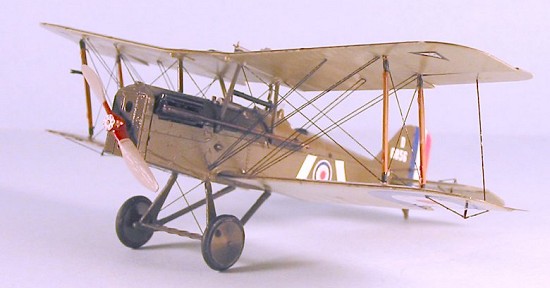 Rigging was accomplished with .008 and .006 brass wire painted gloss
black. The S.E.5a has a fairly complex rigging, but as usual the solution
here is to take one’s time.
Rigging was accomplished with .008 and .006 brass wire painted gloss
black. The S.E.5a has a fairly complex rigging, but as usual the solution
here is to take one’s time.
I then attached the overwing Foster Mounting and the beautifully-molded Lewis gun, and glued the prop on.
| CONCLUSIONS |
This is a more complicated model than the Eduard Camel, if only on the grounds that the rigging is more complicated. That said, it is very easy to build with a logical parts breakdown, and would be a good model for a World War I modeler who has done the Roden Nieuport 28.
To my mind, this is the best 1/48 S.E.5a available. Only the terminally-anal will agonize over the “extra” wing rib, and that can be gotten rid of with “some modeling skill required” for those who can’t live with it. I am sure there will be more than one of these really nice models gracing my collection in the future.
October 2004
| REFERENCES |
Thanks to Roden for the review kit.
You can find this kit and many others at

If you would like your product reviewed fairly and quickly by a site that has nearly 300,000 visitors a month, please contact me or see other details in the Note to Contributors.